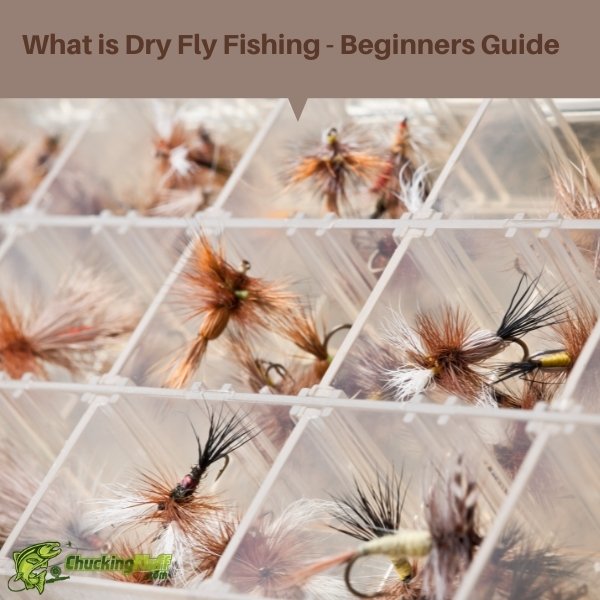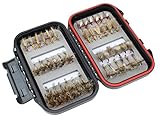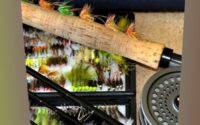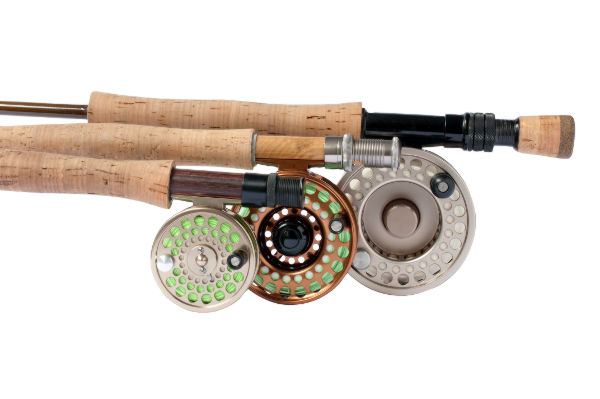| Disclosure: Just to be open and honest the buttons and links you click on in the website will in most cases take you to another website where you can purchase the products I am reviewing. As an Amazon Associate I earn from qualifying purchases. |
What is Dry Fly Fishing? A Beginners Guide

In fly fishing, dry flies are floating flies.
If a fish wants to take a dry fly, it rises to the water surface, and a fisherman/woman strikes to hook it after observing its take.
A dry fly’s dressing is designed to indeed float on the water surface, but don’t confuse this with emergers.
Emerger dressings are meant to sit slightly under the water surface.
Is any of this important?
Well, if you are casting in water that needs you to use dry flies only, that’s where you are trapped!
Using emergers in waters with the dry fly ONLY rule breaks fishery regulations and rules.
Dry fly angling is commonly (but not always) done by roughly casting upstream and allowing your flies to travel towards you.
Most anglers enjoy it because it is a highly visual technique, and the angler watches the fish rising to the water surface to eat a fly.
Quick Post Navigation
When and Where can your Dry Fly Fish?
Dry fly fishing is possible in most trout rivers and streams; however, it is mainly helpful in pools and slower glides where the fish rise freely.
It can be effective in areas where fish are present in riffles.
Knowing the hatches of your area or the water you want to cast in is vital for dry fly anglers.
Dry fly fishing needs you to cast where the fish willingly rise, which is steered by weather, temperature and food availability.
Water Temperature
Temperatures below seven degrees impact the willingness of fish that take dry flies to rise.
The season starts at different times depending on the location, but when it hits, snow could still be on the ground and freezing air and snowmelt from hills send icy water into the rivers.
The weather heavily determines river dry fly angling at this time.
If you are fishing in the winter grips with colder water, fish are slower, sitting closer to the bottom and will hardly rise.
Hatches are present in areas with favorable weather, and dry fly fishing can be successful.
The Winter season begins to end, welcoming spring, and the water temperatures are warmer, thus increasing trout metabolism and their willingness to rise and feed.
Summer has water temperatures warmer, and the scorching sun can have detrimental impacts on trout behavior.
The season sees lulls in dry fly angling, and the best times to cast are dawn and dusk unless the days are cool and overcast.
Autumn temperatures are almost like spring’s and offer excellent dry fly fishing conditions.
Weather Conditions
Bright sunshine is the worst dry fly fishing enemy for most anglers, and it worsens in lower water conditions.
Fish hardly rise in such scenarios and shelter around rocks on river beds or under boughs of any overhanging trees.
You can make the most of bright days by casting under trees and bushes to where the fish are hiding.
It is better to cast in lower light levels like dawn and dusk on brighter, cloudless days.
The best conditions for dry fly angling are mild, overcast and cloudy days.
Slight drizzles are fine, but downpours kill rises.
Dry fly fishing after sharp showers is excellent since numerous insects are hit by rain and thrown from the overhanging trees.
You will notice sudden rises after it stops raining.
Equipment for Dry Fly Fishing
Rods
Most anglers use 9-foot 4-weight fly rods because they are basic setups for most open spaces.
But if casting in areas restricted by structure and trees, shorter rods are ideal.
Going lighter might be great if your river or stream allows it, especially in shorter casting distances or chasing smaller fish.
Medium action rods are preferred, but others enjoy casting with traditional bamboo or cane rods or soft action fibreglass rods.
Reels
River-type fly angling reels are the most appropriate and match your line weight properly.
Small, light reels are the best since plenty of repetitive casts are involved when using dry flies.
Lines
Standard weight forward lines work for dry flies, but some manufacturers have designed special lines for this technique.
Fly line choices can be subjective, and most anglers swear by dry fly specialty lines.
Waders
If you are an occasional angler or on a budget, boot foot waders should will work, but breathable stockingfoot waders are the best if you are a regular angler and can spend more.
Pair them with separate wading boots, and you will thank yourself on days you walk through mushy fields to your spot on warm days.
Leader and Tippet
You will never go wrong with monofilament or copolymer tapered leaders with some feet of tippet on the end.
The tippet must be thinner than the leader for excellent turnovers.
Some fluorocarbon tends to slightly sink on slow-moving water and pull flies under unless plenty of floatant has been added.
You are free to experiment with different leader types like the furled, but if the line, leader and fly don’t turn over well, your casting could be faulty.
Use a good degreaser to degrease your tippet to slightly sink under the water surface and avoid creasing for the first inches to improve presentation.
For a 9-foot fly rod, a 9-foot tapered leader should do with several feet of tippet.
Using tippets isn’t mandatory, but they are more economical if regularly changing your flies.
Potions and Lotions
Real dry flies float perfectly without any treatment.
They sink with splashy casts or in turbulent waters, hence adding a floatant to waterproof them if fishing in such scenarios.
Some powders are available to assist in drying out the flies after catching a fish, and if the fly is sodden.
Accessories
Bring a scoop-style landing net and fasten it to your back to have it out of the way when casting; however, you should easily access it.
You can clip it with a magnetic release.
Dry Fly Fishing Seasons
Spring
Spring is the best time to cast your dry flies because warm water temperatures increase trout metabolism and force them to feed actively.
The first annual hatches appear at this time.
Spring has some cloudy overcast days with the sun lower in the sky, and enough water flowing from winter rains poses excellent conditions for dry fly anglers.
Summer
In summer, warmer water temperatures might increase trout metabolism and feeding habits, but negative factors like brighter sunshine, extremely warm water, and low water level affect the fishing technique.
Trout loathe looking into brighter light and will hardly rise in such conditions.
Rivers with decent flows and some riffles have better oxygen levels, but saturated oxygen levels reduce in low water.
Aim for whiter water to find the fish with good oxygen levels and eager to play.
Autumn
Autumn rain refreshes summer levels, and light and temperature levels reduce.
Dry fly anglers have a tiny window of opportunity to cast before the end of the season, and trout begin to spawn.
Fishing in autumn is similar to spring for a while.
Dry Fly Fishing Tactics and Methods
Prospecting
Casting to an identified rising fish is undoubtedly the most delightful method of catching fish on a dry fly.
There are numerous rivers and streams, especially rainfed, where most fish are caught through prospecting.
Here, prospecting means casting flies into sections you feel might be holding fish even without seeing any rises.
Great areas for prospect casting are in riffles and bubble streams.
Fish are mostly holding in the heads of riffles to catch first dibs on various food options entering pools.
Fish are confident feeders in such areas and love hiding in riffles to keep away from predators.
It can be tougher to spot fish rises in riffles, but more practice makes an angler accustomed to them.
Fish will sit in bubble streams to feed on nymphs and other foods as they move down these bubble streams.
Stalking
Stalking rising fish is an excellent method for clearer waters where you can easily spot fish.
You can stalk certain species in other rivers by casting to their rise without observing them.
It is easier to see rising fish in slow sections of rivers where slight disturbance on the water surface is visible.
Flies
Some essential dry flies to have in your box are up-wings like the mayflies, caddis, midges and terrestrials.
Bring good beetle patterns, black gnats, beetles, daddy long legs, and hawthom flies for terrestrials.
- PROFESSIONAL SELECTION: Wild Water's Premium Fly Assortment takes all the guesswork out of shopping for flies! We selected for you all the flies you need for the best fly fishing experience.
- EASY AND CONVENIENT: This fly assortment comes with a fly box so that you can take all your flies with you. The box measures 4" Width X 6"Length X 1.5" Height and holds up to 372 flies.
- GREAT FOR BEGINNERS: Each pattern is a tried and true performer, effective on a variety of species.
- EVERYTHING YOU NEED: Patterns in this collection include Attractor/Trout Stimulator: 6 Red Humpy, 6 Orange Sedge Hog, 6 Olive Stimulator, 6 Parachute Adams, 6 Yellow Humpy, 6 Yellow Stimulator, 6 Green Double Humpy on hook sizes 12-16.
- CUSTOMER SERVICE: Wild Water has English speaking, USA customer service and product support. We design our own products. We fly fish with our own products. We are always happy to answer any questions about your order. We can answer any technical questions about your product or fix any issue you may have from our USA headquarters.
Dry Fly Fishing Techniques
Dry fly fishing needs precision, controlled casts, and almost perfect turnovers of leaders on the water.
Upstream dry fly fishing is common among anglers, meaning you remain behind the fish as you cast upstream towards it.
Your line should land behind your target, and the fish can only see your fly and leader.
During your casts, flies must run in dead drifts, and you should have hawk eyes out to strike at the slightest rise to your fly.
You can fish dries across the stream if the river has even currents; however, you will not get a lot of time with the fly on the water before a re-cast.
Some anglers dry fly fish downstream though this isn’t their go-to style.
Splashes of fish will be rising behind you, but you still must cover them.
These casts are slightly complicated as you need to make slack like casts and allow flies to run down the river naturally.
Wrap Up
Targeting trout on dry flies is an angler’s ultimate goal.
Approaching this fishing style with the key points mentioned in mind can be intimidating to starters.
As the days go by, you will enhance your angling experiences and triple your success.
Last update on 2025-06-18 / Affiliate links / Images from Amazon Product Advertising API
This product presentation was made with AAWP plugin.



